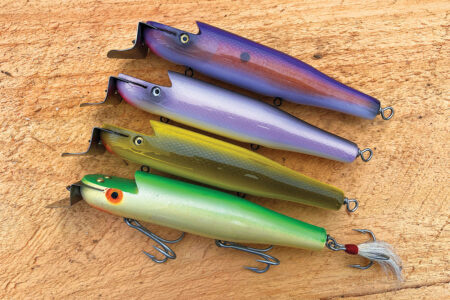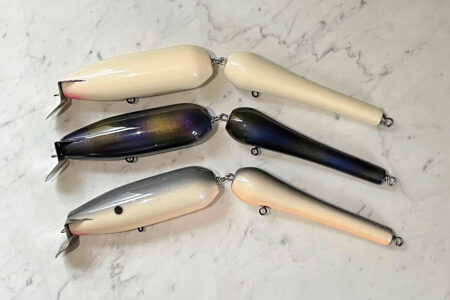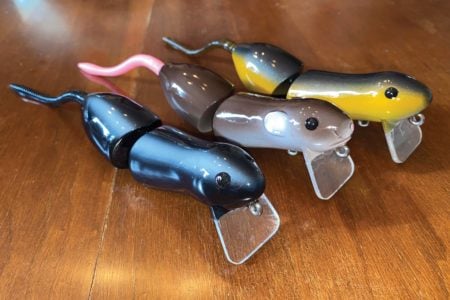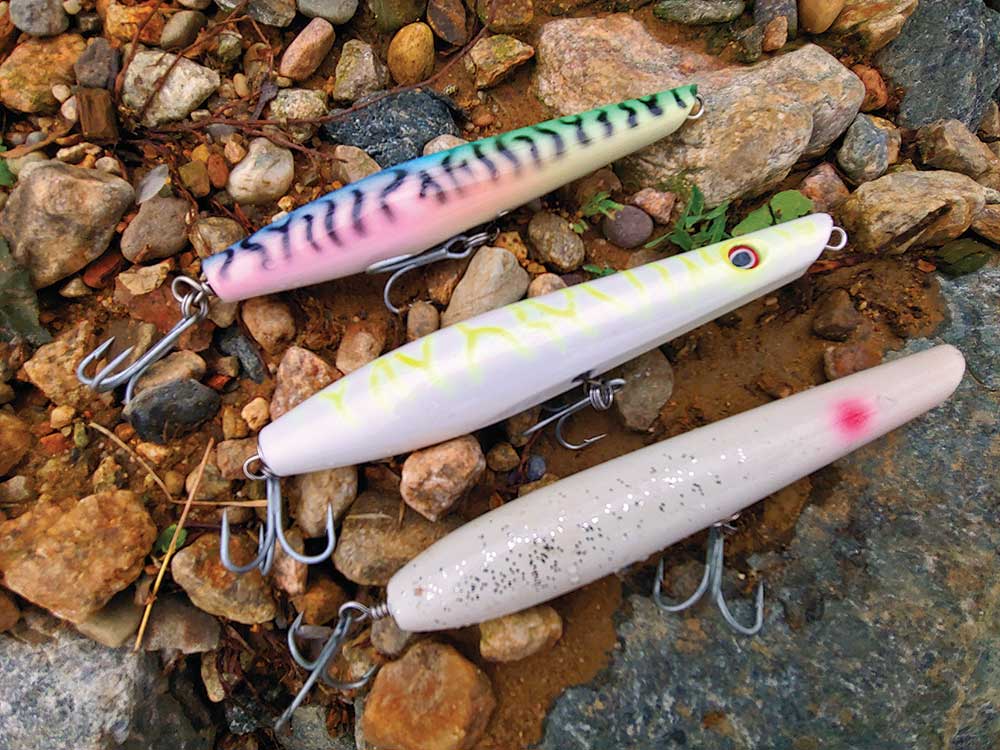
(middle) and Gibbs (bottom.).
Whether you fish the Canal or an open beach, large pencil poppers have a way of consistently drawing strikes from cow bass.
There is nothing more exciting, addictive and heart-stopping than seeing a big striper rise from the depths to smash a surface lure. In the last few years, that go-to surface lure for me has been a big pencil popper. I’ve used these big pencils in the 3-ounce range in the fall along the Rhode Island coastline, and in the summer along the banks of the Cape Cod Canal, to catch some of my largest stripers of the season. These lures have been the most exciting lures to use, and they catch fish when large, aggressive stripers are on big bait. However, not all big pencils are created equally as you’ll learn.
Grab a selection of large (3-plus ounce) pencil poppers off your local tackle store shelf, and you’ll discover that each one casts a bit differently from the next and works differently in subtle ways. If you find a dozen guys lined up in a section of the Canal tossing big pencils, my guess is that most will have a different brand of plug, a different color and most fishermen will put their own twist and spin on the retrieve, giving their lures slightly different actions. Fishermen tend to favor one brand over the next for different reasons.
Good Gear
Large pencil poppers are no different than most other big lures or plugs. Your outfit (rod, reel and line) must all be in balance or in sync to cast these big lures properly. I’ve seen many instances where a novice with a lightweight, whippy rod tried to cast a 3-ounce pencil in vain. The rod bowed on the cast, the lure weakly flew through the air and eventually fell a short distance away like a dead duck. Fishermen right next to these novices with balanced equipment cast the same plug a mile with no problem. A label on the base of the rod usually has a suggested weight of the lures than be cast with that rod, but beware that these weights are often exaggerated.
When using big pencils, both my sons and I use St. Croix Mojo surf rods. We use the 10.5-foot, medium/heavy rods (designated MH). While the label on these rods indicate they will cast 2- to 6-ounce offerings, I can tell you this rod maxes out at about 3 to 4 ounces. Beyond those weights, the rod loses its casting efficiency. Still, they handle my 3- to 3.5-ounce pencils pretty well. I match the Mojo rod with a Daiwa BG 5000 reel and either 40- or 50-pound test Power Pro braided line.
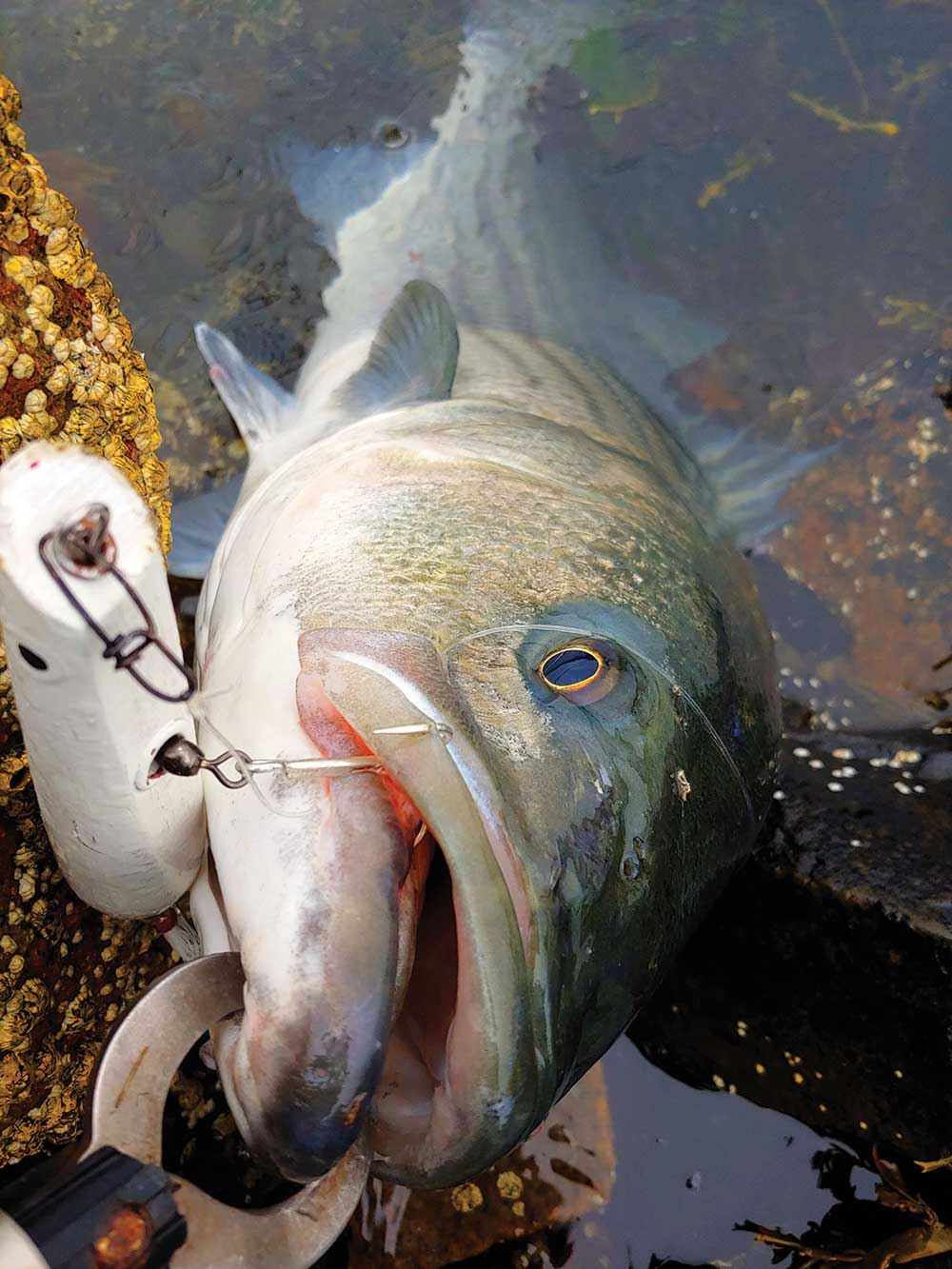
Primary Pencils
Every manufacturer of big pencils has their own weighting scheme built into their lures. Surprisingly, many different models of even the same weight cast slightly differently. Some are thin and loaded with lead. These will sink fast when hitting the water, but rise up quickly on the retrieve. Some are a bit fatter, a bit more buoyant and will track on the surface almost instantly.
My sons and I tried a number of pencils last season at the Canal including Gibbs, Lights Out, Left Hook and Guppy. I also used my own homemade versions, which were the least-effective casters (I’m working on correcting this!) of the bunch. Those brands I tried were used by many Canal casters, and I found they all cast well. The Gibbs, a time-tested Canal favorite had a slight wobble on the cast at times that cut down on distance, but still effectively caught fish. The Left Hook, a brand that a lot of Canal casters use, was a thin pencil filled with lead. It cast like a bullet, and while it sank quickly, it was easy to get moving along the top with a quick crank of the reel right after the plug hit the surface. My son Jon used the Light’s Out pencil a lot. It also cast quite well and was a bit fatter than the Left Hook pencil. My favorite of all was the Guppy Pencil, specifically the Jobo Junior, which was the fattest of all. This gave it good buoyancy, but it also cast like a bullet. In a ghost mac color (white with chartreuse lines), it was my best producer and the plug I had the most confidence in when the fish were hitting on top.
Dance Moves
Besides the model you choose and the way it casts, how you work the pencil is a key element in drawing strikes. One day at the Canal last summer I was fishing a stretch of the Ditch where about a dozen casters were lined-up throwing pencils. No fish were showing on top, but I knew there were fish to be caught as there was one fisherman who put on a clinic for the rest of us. Some of us were using the same plug as he was using, but he was catching as many fish as the rest of us combined. After studying what he was doing differently, I concluded it was his retrieve that made the difference. He hauled his offering way out with his stiff, 11-foot rod, and as soon as the plug hit the water he began a slow retrieve toward the shore. With his right hand about a foot and a half above the reel, he began to pump the rod tip in short, rhythmic pulls while cranking the reel oh-so-slowly with his left hand; he was barely turning the reel. His plug would do an alluring ‘windshield wiper dance’ on the surface while being pulled in the current and coming ashore so slowly. It was that slow retrieve that did it, and it got me to really slow down my retrieve when fishing pencils in the Canal. It proved to be a very effective technique as the season wore on, often producing fish when standard-speed retrieves failed to draw a strike.
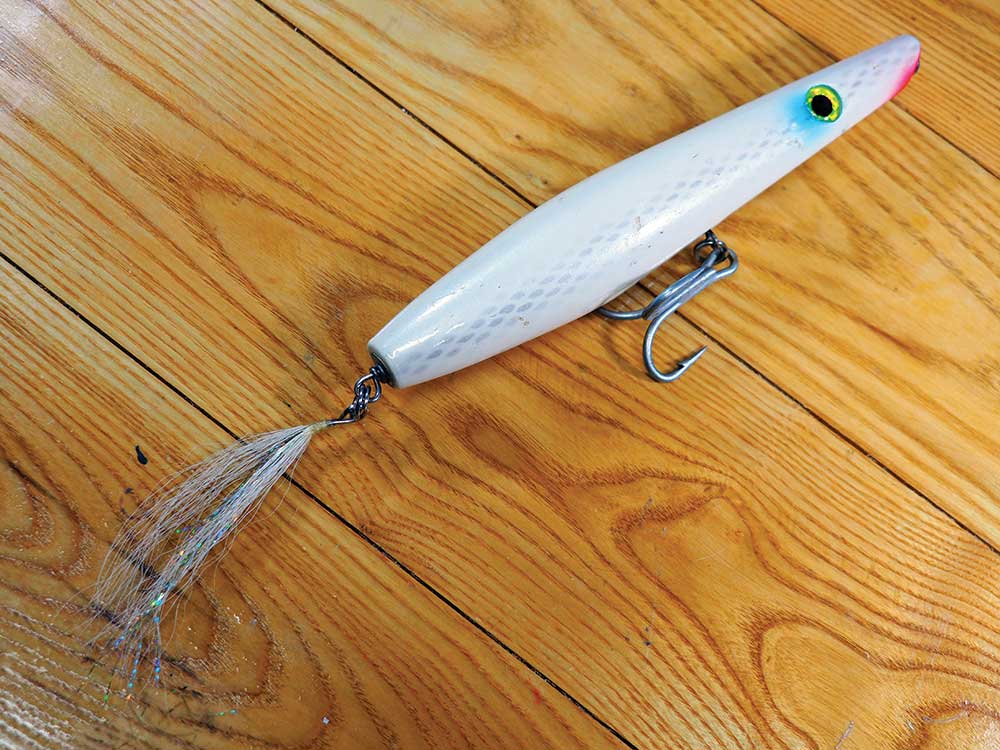
(Photo by Toby Lapinski)
When buying a big pencil popper, take notice of the underside of the plug. Most experts will tell you that flat-bellied pencils track better in fast-moving water, while round-belly models work better in an open surf. Most of the plugs I described above that I used at the Canal were flat-bellied models, and I have a number of round-belly models that I use in the surf when big bait is around in late fall, but this not a hard-and-fast rule. Don’t be afraid to experiment with different body shapes to find what works best in a given scenario.
Finally, color is often a big factor when the fish turn fussy, but in general a basic white pattern works best for me. That white color is great to mimic such big bait as squid, mackerel and herring. When those thin profile baitfish are around, pencils can be very effective. At the Canal another favorite color is a mackerel version when that bait is in the Canal.
In the offseason I plan to stock up on various models of pencil poppers to use during the upcoming fishing season. I’m sure many of you have your favorite brands. If you plan to fish the Canal in the upcoming season, it is those bigger pencils in the 3-ounce range that have the ability to really get noticed. The brand, the weight, the color and the suggested weight of plugs that your outfit efficiently casts are all factors to consider when purchasing pencil poppers.

